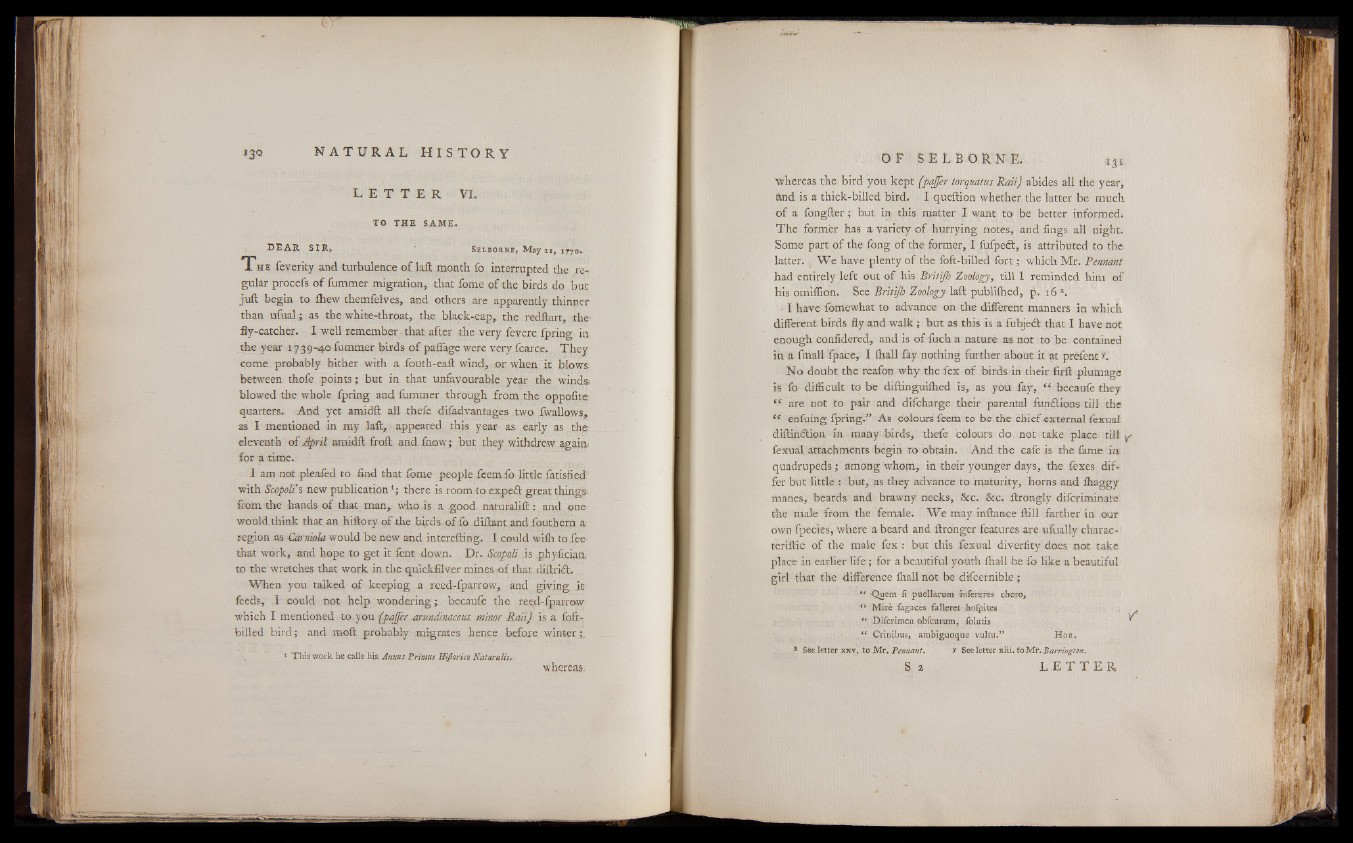
L E T T E R VI.
T O TH E S A M E .
D E A R S I R , • Sel bo r n e , May n , 1770-..
T he feverity and turbulence of laft month fo interrupted the regular
procefs of fummer migration, that fome of the birds do but
juft begin to Ihew themfelves, and others are apparently thinner
than ufual; as the white-throat, the black-cap, the redftart, the
fly-catcher. I well remember diat after the very fevere fpring in
the year 1739-40 fummer birds o f paffage were very fcarce. They
come probably hither with a. fouth-eaft wind, or when it blows
between thole points; but in that unfavourable year the wind»
blowed the whole fpring and lummer through from the oppolite
quarters. And yet amidft all thefe difadvantages two fwallows,
as I mentioned in my laft, appeared this year as early as the
eleventh of April amidft froft and fno w; but they withdrew again
for a time.
I am not pleafed to find that fome people feemfo little fatisfied'
with Scopoli’s new publication *; there is room-to expefi great thing»
from the hands of that man, who is a good naf uralift: and one-
would think that an hiftory of the birds of fo diftant and fouthern a
region as Carnmh would be new and interefting. I could wilh to fee-
that work, and hope to get it. lent down. Dr. Scopali is phyfician-.
to the wretches that work in die quickfilver mines o f that diftraft.
When you talked of keeping .a reed-fparrow, and giving it
feeds, I could not help wonderingbecaufe the reed-fparrow
which I mentioned to. y ou {pafler arundinaceus minor JS.aH) is a foft-
billed bird; and moft probably migrates hence before, winter
* This work he calls his. Annus 'Primus Hiftorica Naturalisewhereas,
whereas the bird you kept (pajfer torquatus Raii) abides all the year,
ând is a thick-billed bird, I queftion whether the latter be much
of a fongfter ; but in this matter I want to be better informed.
The former has a variety of hurrying notes, and lings all night.
Some part of the fong of the former, I fufpedt, is attributed to the
latter. We have plenty of the foft-billed fort ; which Mr. Pennant
had entirely left' out of his Britijh Zoology, till I reminded him of
his omiffion. See Britijh Zoology laft publilhed, p. 16 *.
- I have fomewhat to advance on the different manners in which
different birds fly and walk ; but as this is a fubjedt that I have not
enough confidered, and is of fuch a nature as not to be contained
in a fmall fpace, I lhall fay nothing further about it at prefent
No doubt the reafon why the fex of birds in their firft plumage
is fo difficult to be diftinguilhed is, as you fay, » becaufe they
“ are not to pair and difcharge their parental functions till the
*c enfuing fpring.” As colours feem to be the chief external fexual
diftinction in many birds, thefe colours do not take place till y
fexual attachments begin to obtain. And the cafe is the lame in
quadrupeds; among whom, in their younger days, the fexes differ
but little : but, as they advance to maturity, horns and ffiaggy
manes, beards and brawny necks, &c. &c. ftrongly difcriminate
the male from the female. We may inftance ftill farther in our
own fpecies, where a beard and ftronger features are ulually charac-
teriftic of the male fex : but this fexual diverfity does not take
place in earlier life ; for a beautiful youth lhall be fo like a beautiful
girl that the difference lhall not be difcernible ;
“ *Quem ft paelkrum mfereres cher-o,
“ Miré fagaçes falleret ko{pites
“ Difcrimen ©fofcumm, iblutis ^
Jjfij Crinibus, ambiguoque vultii.” H or.
* See letter xxv. to Mr. Pennant, Y See letter xlii. to Mi4. Barrington.
S a L E T T E R